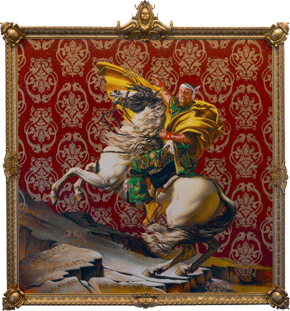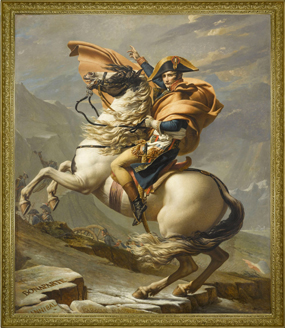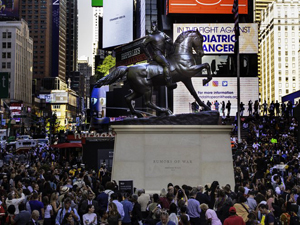Rivalry or Emulation?
John Haberin New York City
Kehinde Wiley, Jacques-Louis David, and Napoleon
Kehinde Wiley in Sculpture
The Brooklyn Museum is so proud of bringing together Kehinde Wiley and Jacques-Louis David that it does not bother with a sign out front. Class, it appears, speaks for itself. And what of Wiley's sculpture in Times Square and Monument Avenue in Virginia? Has he set aside the glitter and the street? Not for a minute.
A touch of class
The doors leading in bear only the initials of their last names, overlapping, in a font suitable for royalty. They share a lengthy time line as well, boasting of their place in history. The museum has purchased Wiley's Napoleon Leading the Army over the Alps,  and it has borrowed David's equestrian portrait that served as its model. (It speaks of the former as the forty-two year old's "iconic" work.) Red stage curtains part for the same monogram at the exhibition's center, with the paintings to either side. From this moment on, it wants to say, the artists and their reputations are as intertwined as those letters.
and it has borrowed David's equestrian portrait that served as its model. (It speaks of the former as the forty-two year old's "iconic" work.) Red stage curtains part for the same monogram at the exhibition's center, with the paintings to either side. From this moment on, it wants to say, the artists and their reputations are as intertwined as those letters.
Not that they get along quite so comfortably. The walls for the paintings angle forward, so that they face off. Kehinde Wiley fashioned his 2005 portrait on the same epic scale as David's from 1801—and with the same heroic pose for his horse and rider. He also demands some improvements. An icy gray sky and troops dragging artillery have given way to a rich floral tapestry that should, no doubt, have served as a backdrop for David if only the Frenchman had duly weighed his subject's dignity in gold. Napoleon himself has given way to an African American with no less confidence but a greater bulk and beard.
He has, in short, exchanged the future emperor of France for his stock subject—a young black male off the streets against a decorative patterning, strutting his stuff, much like another African American, Mickalene Thomas. He knows that the rearing horse makes no sense in his studio. But then it did not make all much sense in Saint Bernard's pass in the Alps, where Napoleon pulled off a stunning invasion of Italy and Austria. Wiley retains the foreground rocks, but again with an improvement. He has added his sitter's last name to the others inscribed there, including Bonaparte, Hannibal (who crossed the Alps on his way to victory over ancient Rome), and Carolus Magnus (or Charlemagne, the Holy Roman Emperor). Wiley claims an impressive ancestry.
Are the artists, then, a master and pupil, equals, or rivals? Is Wiley paying tribute to the founder of Neoclassicism, appropriating him, or taking him down? As ever, he wants to have his cake and eat it, too, with no veggies first, thank you. So does the museum, which sets the paintings past coins and other representations glorifying Napoleon, while casting the realism of David's version in doubt. Still, merely to ask lends insight, and the hype makes sense as the show's true subject. It is about crafting an image.
For all the hype and craft, Wiley's art can feel as shallow as the space of his painting, even when he paints pop stars like Swizz Beatz and Alicia Keys or street dancers in the clouds for an expanded Penn Station. It did in past shows, before he pulled off with Amy Sherald more impressive official portraits of President and Michelle Obama, and it did again last year, when he adapted his horse and rider to public sculpture. A reduced version appears in Brooklyn—while the original has moved on to the company of Confederate monuments in Richmond. In all fairness, though, the same questions bedevil Jacques-Louis David. Had David betrayed his own dear cause, the French republic? Had he betrayed, too, his own revolution in art?
Napoleon had his provocatively mixed record, too. He began as a supporter of Corsican independence from France, attended military school in France, went against the conservative grain of the military, backed the most radical faction of the French Revolution, instituted his fair share of reforms as first consul, seized power "for life," and killed off the still nascent republic. He could count on popular support as the continuance of the revolution and in putting an end to its terrors—that on top of military victories and the power of a police state. He even brought David down to earth. The artist had wanted to show Napoleon in battle, but the general pointed out that his fancy pose had no place there. The painting hangs in the Château de Malmaison, the mansion just outside Paris that he adopted as a second official residence.
Realism as idealization
It was a turning point for David, on his way to later portraits of wealth, the aristocracy, and the pope. He was also becoming a factory. He first painted the scene for the king of Spain, who hoped to flatter Napoleon, and it seems to have worked.  At Napoleon's request, he made the copy in the Malmaison, and his studio added three more. It does away with the starkness of his earlier paintings of Jean Paul Marat, the revolutionary, left for dead in a bathtub and Socrates pointing up while reaching for the hemlock. Now Napoleon and his steed can defy gravity.
At Napoleon's request, he made the copy in the Malmaison, and his studio added three more. It does away with the starkness of his earlier paintings of Jean Paul Marat, the revolutionary, left for dead in a bathtub and Socrates pointing up while reaching for the hemlock. Now Napoleon and his steed can defy gravity.
Still, David's bold realism always depended on idealization. He became famous for Oath of the Horatii, four years before the storming of the Bastille. What could be simpler than the outstretched arms of the men in arms—or the bare arches behind them? What could be plainer, as a statement of virtue or as art? While many today prefer the portraits of J. A. D. Ingres, his greatest pupil, to his own, David would have found them exaggerated. The French academy, in fact, at the time agreed.
He worked fast, because he was following the news and making news, just as during the revolution. He began the first version the same year as the alpine crossing—and three years before Napoleon declared himself emperor. He was still keeping up with events when he painted Napoleon crowning the empress, Josephine. The scene has just become an overblown tapestry rather than concise and classical. Still, his late portraits have their own simplicity and warmth. Besides, his Napoleon on horseback still served as a model for Baron Gros, a pupil whose broader brush and warmer colors mark the transition to Romanticism.
Napoleon, the exhibition points out, could not have braved that difficult passage on horseback, in full-dress uniform. He rode an ass and wore a heavy cloak, as in a painting by Paul Delaroche. Still, that revisioning came only fifty years later, when the very meaning of realism was changing. David did not take off from it and embellish it, leaving the cold facts behind. Nor could he have painted from life, given the commission from Spain rather than Napoleon himself—and his distance from the Alps. He just trusted to the meaning of the event, his command of appearances, and his imagination.
Wiley does much the same, if with a rather heightened trust. He treasures his time in museums almost as much as urbanstreet life, and museums are returning the favor, warranted or not. If there is something silly about the whole deal, he treasures that, too. The young man dresses in camo and the white kerchief of the walking wounded, rooting him at once in war and in fashion. His paramilitary green complements the yellow of his cloak, the red of the tapestry, and the gilt of its weaving. Like Napoleon, he is claiming victory even before the first battle.
Brooklyn cannot deliver on its claims for Wiley, but it can does deliver on the questions and contradictions. If it, too, goes overboard, so be it. Harsh lighting submerges the paintings in glare and threatens to make David's highlight the horse's ass, but it has its benefits as well. It picks out that one spot of bare white flesh, linking it to David's earlier beggars and revolutionaries, if only in another species. It brings out Wiley's hard-edged color, too, to the point that his horse seems to smile. After two hundred years of glorification, it may well have the last laugh.
Regards to Broadway
Kehinde Wiley was always as much an entertainer as a painter. It shows in his upbeat portraits and the glitzy, decorative patterns behind them. His sitters, too, are out to entertain, much as Tyler Mitchell just wants to make an African American feel good. Wiley may take them from the streets, but they strut their stuff, and they have left the community behind. Sure enough, his first public sculpture plops down just north of Times Square, amid tourists, theaters, and Jane Dickson—right next to the greatest showman of them all, George M. Cohan. Give my regards to Broadway.
Sure enough, too, it depicts a young black male, fashionably dressed in jeans torn at the knee. Did you really think that Wiley would stick to the maturity of his most famous sitter, Barak Obama? (Sherald, who painted Michelle Obama, has not either, but then she is mature enough herself.) It is a state portrait all the same, only for another state of the union. It is headed for Arthur Ashe Boulevard in Richmond and the Virginia Museum of Fine Arts, in company of the monuments on Monument Avenue. It should offer a proper New York challenge to their stately presence and Confederate propaganda.
They may look downright reserved by comparison. Wiley calls it Rumors of War, but this artist does not do innuendo. He sets the man on horseback, like Robert E. Lee, but with an elbow cocked, a hand firmly on his rear, and more than a quarter turn to the side. An African America, he knows, had better watch his butt. Not that he is looking back, not when he can grip the reins and march on ahead. This means war. 
The horse seems no less proud. Its long nose draws right down, mouth wide open, and its tail flies back. Its back legs, too, are cocked, and a front leg rears up—in a tradition that goes back to an unfinished equestrian monument by Leonardo da Vinci. Its unsteady pose was an engineering marvel, assuming he could have pulled it off, but things are easier nowadays. And Leonardo, too, liked a challenge. He was also paying tribute to the military might of a dictator, while Wiley has a popular uprising more in mind.
The statue looks glib enough in photographs, but it means to boast. Politics, for Wiley, should get along just fine with entertainment. Besides, photos take a high vantage point to relish the effect, and things are quite different looking up. The horse's bulk tempers its rider's overkill. Its raised front knee seems to nestle within its open jaws, and the flare of its tail parallels the young man's spiky hair in the wind. But, hey, you came not for all that sophistication, but for fun.
Then, too, Rumors of War may have been at its best in context of New York—though still, as Holland Cotter puts it, all to "close in spirit to the bellicose models it is meant to confront." It could even look halfway funny, as a challenge to its bustling, pretentious, touristed surroundings. They could use it. Richmond is likely to welcome the challenge as well. Meanwhile Wiley can go back to painting and to the streets. A true showman can do no less.

Kehinde Wiley and Jacques-Louis David ran at The Brooklyn Museum through May 10, 2020. Wiley's sculpture sat in Father Duffy Square through December 1, 2019, before leaving for the Virginia Museum of Fine Arts. A related review looks at Jacques-Louis David drawings. Holland Cotter's article appeared in The New York Times on August 17.




